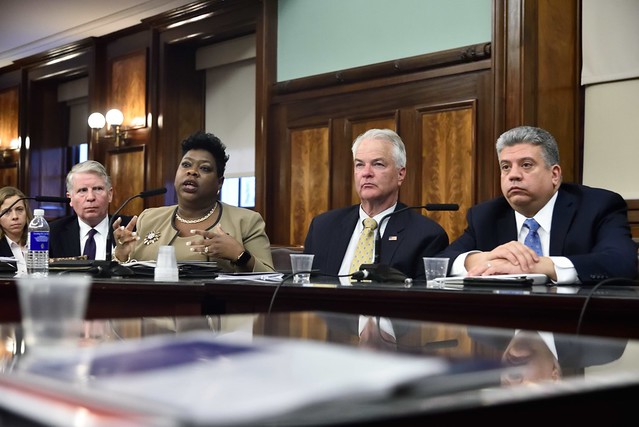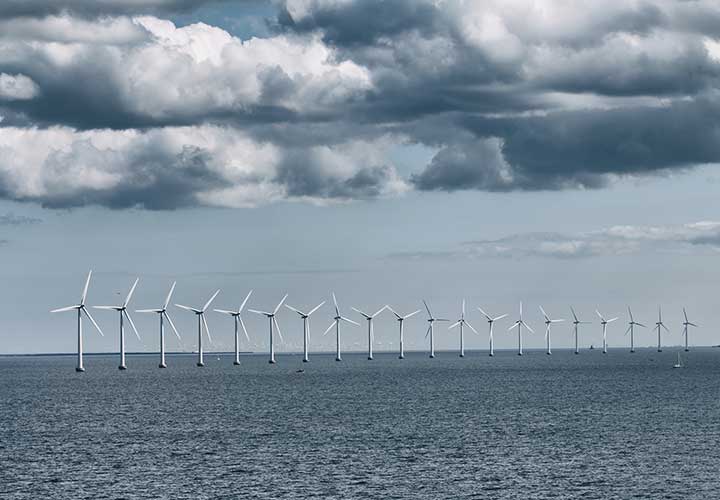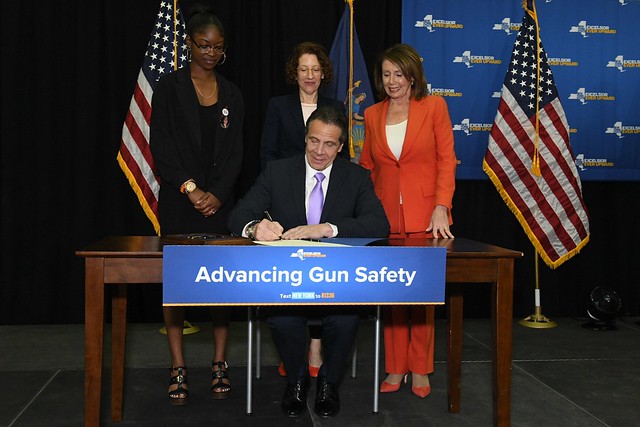American Prosecutors Need Not Wait for Marijuana Legalization

Four New York City District Attorneys (photo: John McCarten/City Council)
Last week, Governor Cuomo signed a bill effectively decriminalizing recreational use of marijuana. Once in effect at the end of August, New Yorkers charged with possession of less than two ounces of marijuana will face fines instead of criminal charges. Possession of over two ounces of marijuana maintains high fines and the possibility of jail time.
It is well known that throughout the United States communities of color have been disproportionately affected by marijuana arrests. In 2018, 89% of all New Yorkers arrested for marijuana possession were black or Hispanic; only 7% of people arrested for marijuana possession in New York were white.
The new law fails to address the disparate impact of the pernicious enforcement of marijuana use as grounds for parole and probation violations, but thankfully will allow people already convicted of low-level marijuana possession to have those charges expunged from their criminal records.
This law is an important legislative step towards addressing the over-policing and over-prosecution of our communities, and brings about a statewide change that has already been successfully piloted in parts of New York City thanks to local prosecutors’ sound use of their discretionary power.
In 2014, then-Brooklyn District Attorney Ken Thompson implemented a policy declining to prosecute possession of small amounts of marijuana. In 2018, Manhattan District Attorney Cyrus Vance declined to prosecute low-level marijuana possession in his jurisdiction and vacated 3,000 cases and bench warrants for possession and smoking of marijuana. In February 2019, Bronx District Attorney Darcel Clark declined to prosecute low-level marijuana possession.
These efforts have been mirrored in other states as well. Baltimore District Attorney Marilyn Mosby rightly announced in February that “prosecuting [marijuana] cases ha[s] no public safety value, disproportionately impacts communities of color and erodes public trust, and is a costly and counterproductive use of limited resources.”
Prosecutors across the country should follow the example of these district attorneys. Using their powers, prosecutors don’t need to wait for state or federal marijuana decriminalization or legalization to provide justice.
Prosecutors use their discretion every day to tailor their recommendations on cases; the decision to decline to prosecute certain crimes that do not affect public safety is one way prosecutors should use that discretion to reduce the negative impact of the criminal justice system on communities of color, build trust with the communities they serve, and reduce interactions with the criminal justice system that may cause harm despite benign intent on the part of the system.
Regardless of the outcome of any particular case, contact with the criminal justice system can affect an individual’s employment, interrupt child care, and make community members feel unsafe due to unnecessary system pressure. For prosecutors managing offices with heavy caseloads, the decision to decline to prosecute cases that do not increase public safety is also a strategic one. By lowering caseloads, prosecutors are able to reallocate resources to finding
innovative, evidence-based, restorative responses to serious crimes that cause true harm to our communities.
Local prosecutors across the country have the potential to impact countless people through the thoughtful use of their discretion in ways that reflect local values while prioritizing the safety of all. As New York has demonstrated, prosecutors need not wait on state or national legislative solutions to enact policies that will help enable communities to thrive.
***
Lucy Lang is the Executive Director of the Institute for Innovation in Prosecution at John Jay College of Criminal Justice. On Twitter @LucyLangNYC.
***
Have an op-ed idea or submission for Gotham Gazette? Email This email address is being protected from spambots. You need JavaScript enabled to view it.
Note: this column has been corrected to note that the Brooklyn DA office announced its policy in 2014 under then-DA Ken Thompson.
As New York’s Ambitious Energy Plan Breaks Offshore Wind Records, Report Identifies Challenges and Opportunities

(photo: Energy.gov/NREL.gov)
The offshore wind energy revolution has arrived on American shores. In a relatively short period of time, East Coast states are breaking offshore wind records as they compete with each other over wind power. A recent report, though, by the Business Network for Offshore Wind finds that industry challenges will slow growth unless offshore wind states work together to find solutions.
Recently, New York Governor Andrew Cuomo launched the largest offshore wind project in the country. His climate change bill codified 9,000 megawatts of offshore wind power into law, which will produce clean energy for over 3.4 million homes. Similar record-breaking news has been announced in other East Coast states but problems with grid connections, transmission lines, port infrastructure, marine logistics, and employee training can stand in the way of reducing carbon emissions with ocean power quickly and efficiently.
The speed behind the development of ocean power is one of the most important races the United States must run to strengthen our environment, our economy, and our job growth. Today the U.S. has one offshore wind farm consisting of five turbines, compared to Europe’s 4,543 grid-connected offshore wind turbines across 11 countries. During the next two decades, East Coast states and California will have over two-dozen offshore wind farms under development in various stages.
Our states have demonstrated they can and will play a critical role in the global renewable energy market, but we have work to do if we wish to ascend to a top leadership position globally. With the help of over 100 offshore wind experts, the Network’s Leadership 100 report focuses on the demands facing the industry with recommendations to meet them.
For example, New York, New Jersey, and Massachusetts are accelerating their goals for a total of almost 16,000 megawatts (MWs) in offshore wind power. But, as of right now, the Northeast grid will be challenged in capacity to produce beyond 4,000 MWs.
The report argues that a project-by-project approach to grid connection is necessary to get the first turbines in the water. However, once the first few projects are constructed and connected to the grid, it will be difficult to reach the goals set forth by states without a coordinated grid approach. This means states need to build and pay for one grid for all states on the East Coast.
Port infrastructure is another obstacle. The report recommends that port infrastructure for offshore wind should be built and its use distributed among states, meaning some states will use port infrastructure in other states to support different parts of a project, and other states may not need to build offshore wind ports at all.
Unique and customized solutions for the U.S. offshore wind industry will give way to yet unknown spin-offs. For example, a bonus industry for the East Coast region is a marine logistics industry. With multiple developers and utilities involved in different states, marine logistics will be critical for coordinating the use of vessels and ports.
Also, as the report explains, bottlenecks will occur, along with setbacks, if the U.S. does not inventory what it can do well and focus on these few things. State competition needs to be resolved and a recognition that not everything can be built in the U.S. is also required.
Overall, there is confusion within the states about the labor, skills, and training needed for offshore wind production. Industry leaders also are confused on where to access training. Our workforce development system is daunting and needs improvements.
The Network’s report includes recommendations for offshore wind states for advancing grid and transmission projects, developing an industry road map and launching a public engagement campaign. The offshore wind supply chain has the potential to reach every state. We all want an American industry operated with American content, intelligence, and know-how. Let the race for ocean power begin but let’s all get on the same team.
***
Liz Burdock is President and CEO of Business Network for Offshore Wind. Jay A. Borkland is Senior Engineering Manager for Lloyd’s Register Boston Office of Renewables. On Twitter @LizBurdock1 of @offshorewindus.
How Many Must Die for Change - Corrupt Campaign Finance Laws Pave Way for Only ‘Thoughts and Prayers’

(photo: the governor's office)
After the Gilroy, El Paso, and Dayton massacres of the last two weeks, many Americans are asking how many more Stephen Romeros have to die before we stop the corporate, state-sponsored domestic terrorism of the gun-rights lobby. If you need to take a tally of children killed by guns, start with Stephen, and then include the 20 children of the Sandy Hook school shooting of 2012, then add Parkland and don't forget Keyla and Trevor, who were killed with Stephen that day in Gilroy.
When we are done counting the dead, the number of children killed by firearms every year in the United States is in the thousands!
No person should fear walking out their door. We should be free to attend a movie, go to the mall or a concert, congregate to celebrate one’s faith, or have fun at a festival with our friends and family without looking over our shoulder or imagining someone showing up with an AR-15. No one should be wondering if today is the last day they will see their child alive when they send them off to school.
This is terrorism, enabled by a dysfunctional Congress that accepts the legalized bribes of the gun lobby and weapons manufacturers and executives. Campaign funds and Super-PAC money from the gun lobby are used to influence federal government decisions to do nothing but send thoughts and prayers to the devastated families and many millions more who live in fear of being next.
Recent polls show a majority of Americans want more safety from guns. Overall 61% support stricter gun laws in the U.S., 77% support requiring a license, and 63% support a nationwide ban on assault weapons. And 94% support background checks, even a vast majority of NRA members who were polled, 69%, are in favor of background checks. The safety of our children isn’t a partisan issue, it’s a necessity and Americans know that. Why doesn’t Congress?
The obvious reason for Congressional inaction is partisanship. The gun lobby, especially the NRA, floods Republican coffers with campaign contributions from their various Super PACs and for decades used their money to campaign for a majority of Republicans and against Democrats. Making gun legislation a partisan issue and creating division within the Republic. They have in effect enforced a paid for blockade on gun safety legislation from the majority of Republicans.
Inaction in Washington, D.C. can be contrasted with action in Albany.
New York legislators and Governor Andrew Cuomo are creating safer communities for all. Most recently, New York has passed several gun safety measures like the Red Flag law andextending the waiting period from three days to 30 during a delayed background check. They banned the sale of bump stocks in the state and passed mandatory lock and storage for gun safety in the home. They defied the culture of fear when they banned teachers from carrying firearms.
These 2019 accomplishments followed the passage of 2013 gun laws in New York that came just after the Sandy Hook elementary school massacre, measures that included a ban on assault weapon sales.
While some states like New York might be leading, Americans need and are asking for Congress to pass national comprehensive gun safety laws, which are especially necessary where there is no state-level leadership.
Congress won't act until we get rid of the corruption of big money in politics. The gun lobby has spent millions in legalized bribes to Congress, through campaign contributions and Super PACs and other dark money groups. This flow of money to campaign coffers ensures that regulations on the industry are almost non-existent. Those who can pay to play buy Congress’ attention, it’s a fact. The American people can lay the dead at Congress’ feet and still, they’d step over the corpses of our children to grab a check from a gun lobbyist.
The problem of money in politics is linked to the crisis of mass shootings and the domestic terrorism that we as a society face daily. Americans can do more than pray for a better tomorrow, we can demand legislative change to end the corruption that is preventing a safer, better world for our children.
That change needs to come in the form of an amendment to our United States Constitution for campaign finance. Once we have that, we can end the stranglehold of the gun lobby on Congress and that leaves the peoples’ voices to be heard. If Americans want a nation of safer schools and safer communities, we need to end this corruption now.
***
Joseph Sackman is the national coordinator for Wolf PAC. On Twitter @WolfPAChq.
***
Have an op-ed idea or submission for Gotham Gazette? Email This email address is being protected from spambots. You need JavaScript enabled to view it.




